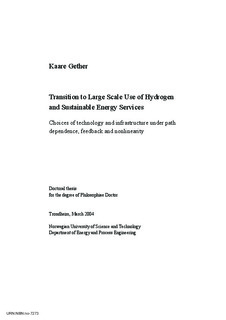| dc.contributor.author | Gether, Kaare | nb_NO |
| dc.date.accessioned | 2014-12-19T11:43:41Z | |
| dc.date.available | 2014-12-19T11:43:41Z | |
| dc.date.created | 2004-06-15 | nb_NO |
| dc.date.issued | 2004 | nb_NO |
| dc.identifier | 124180 | nb_NO |
| dc.identifier.isbn | 82-471-6354-3 | nb_NO |
| dc.identifier.uri | http://hdl.handle.net/11250/233367 | |
| dc.description.abstract | We live in a world of becoming. The future is not given, but forms continuously in dynamic processes where path dependence plays a major role. There are many different possible futures. What we actually end up with is determined in part by chance and in part by the decisions we make. To make sound decisions we require models that are flexible enough to identify opportunities and to help us choose options that lead to advantageous alternatives. This way of thinking differs from traditional cost-benefit analysis that employs net present value calculations to choose on purely economic grounds, without regard to future consequences.
Time and dynamic behaviour introduce a separate perspective. There is a focus on change, and decisions acquire windows of opportunity: the right decision at the right time may lead to substantial change, while it will have little effect if too early or too late. Modelling needs to reflect this dynamic behaviour. It is the perspective of time and dynamics that leads to a focus on sustainability, and thereby the role hydrogen might play in a future energy system. The present work develops a particular understanding relevant to energy infrastructures.
Central elements of this understanding are:
- Competition
- Market preference and choice beyond costs
- Bounded rationality
- Uncertainty and risk
- Irreversibility
- Increasing returns
- Path dependence
- Feedback
- Delay
- Nonlinear behaviour
Change towards a “hydrogen economy” will involve far-reaching change away from our existing energy infrastructure. This infrastructure is viewed as a dynamic set of interacting technologies (value sequences) that provide services to end-users and uphold the required supply of energy for this, all the way from primary energy sources. The individual technologies also develop with time.
Building on this understanding and analysis, an analytical tool has emerged: the Energy Infrastructure Competition (EICOMP) model. In the model each technology is characterised by a capacity, an ordered-, and an actually delivered volume of energy services. It is further characterised through physical description with parameters like efficiency, time required for extending capacity and improvement by learning. Finally, each technology has an attractiveness, composed of costs, quality and availability, that determines the outcome of competition.
Change away from our present energy infrastructure into a sustainable one based on renewable energy sources, will entail substantial change in most aspects of technology, organisation and ownership. Central results from the overall work are:
- Change is dynamic and deeply influenced through situations with reinforcing feedback and path dependence. Due to this, there is a need for long-term perspectives in today's decision making: decisions have windows of opportunity and need to be made at the proper time.
- Strategies aimed at achieving change should team up with reinforcing feedback and avoid overwhelming balancing feedback that counteracts change.
- The EICOMP model is now available as a tool for furthe analysis of our existing energy infrastructure and its dynamic development into possible, alternative energy futures. As the model is intended for practical guidance in decisions, a central practical aim has been to allow it to be used close to where decisions are actually made; i.e. decentralised and locally in firms and in public institutions. In this respect much effort has been made in an attempt to make it transparent and easy to communicate.
- The EICOMP model may be used to analyse situations of reinforcing feedback throughout the alternative energy infrastructures that we may come to have in the future. | nb_NO |
| dc.language | eng | nb_NO |
| dc.publisher | Fakultet for ingeniørvitenskap og teknologi | nb_NO |
| dc.relation.ispartofseries | Doktoravhandlinger ved NTNU, 1503-8181; 2004:71 | nb_NO |
| dc.title | Transition to Large Scale Use of Hydrogen and Sustainable Energy Services and nonlinearity: Choices of technology and infrastructure under path dependence, feedback | nb_NO |
| dc.type | Doctoral thesis | nb_NO |
| dc.source.pagenumber | 216 | nb_NO |
| dc.contributor.department | Norges teknisk-naturvitenskapelige universitet, Fakultet for ingeniørvitenskap og teknologi, Institutt for energi- og prosessteknikk | nb_NO |
| dc.description.degree | PhD i energi- og prosessteknikk | nb_NO |
| dc.description.degree | PhD in Energy and Process Engineering | en_GB |
